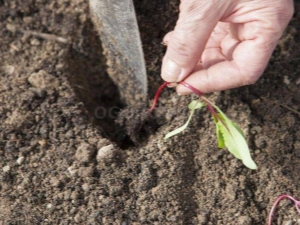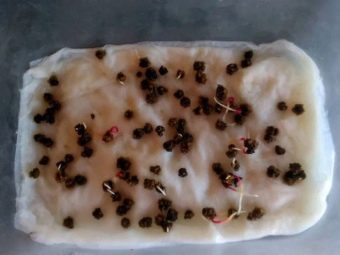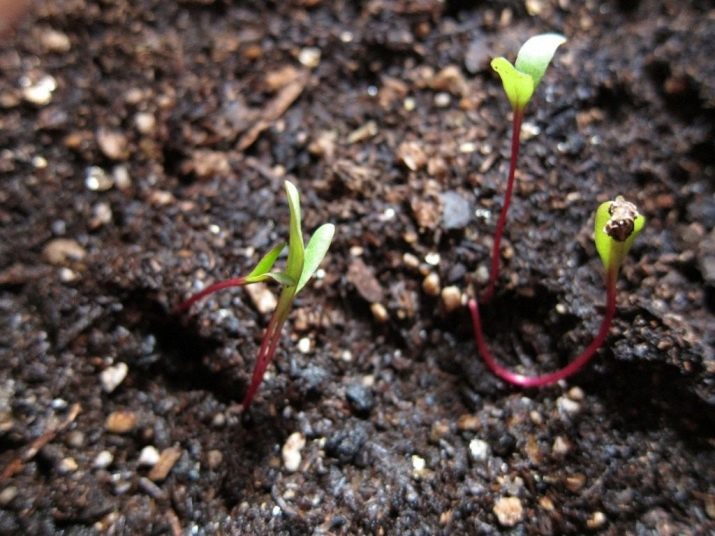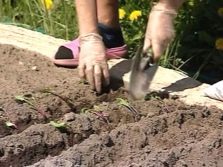Subtleties planting beet seedlings in open ground

Beetroot is a taste from childhood.Some adore her, while others hate her. This root crop is famous not only for its color and taste, but also for its beneficial properties. In addition, beets are a vegetable familiar to our region. Many people know a simple way to grow beets - sowing seeds in open ground. But not so common way of planting beet seedlings, although it is much more effective. It is thanks to the second option, you can enjoy beets in July.
Variety selection
Planting beets begins with the correct choice of variety. It is of three types: dining, fodder and sugar. The appropriate type is selected depending on the needs. So, red beet is perfect for nutritional needs, and fodder beetle - for feeding livestock. It is logical that sugar is extracted from the latter, because many people are familiar with the expression beet sugar. To choose the right type of beet, it is worth starting from personal preferences, because they differ in taste and size, as well as in shelf life. You should buy seeds, based on their own experience and expert advice.
Regarding care, it is different for each grade. So, sugar beet is the most demanding. It needs to be fertilized, to monitor the soil and climate change. This is one of the reasons why this species is not popular among summer residents. But feed and dining are less dependent on care. For example, the main thing for table beets is a large amount of sunny color.
By the way, this is why it is not recommended to plant tall plants with a large crown next to it.
Seed germination
You need to start training in mid-April. If you start earlier, the fragile seedlings will die. The optimal time is the 15-20 of April. When landing at home, it is important what temperature will be created. In 3-4 weeks, the shoots will ascend at +5 degrees Celsius. Ten days will be enough for the seeds at a temperature of +10 degrees, and already at +15 degrees the sprouts will grow on the third day.
The first stage is the selection of seeds. It is necessary to sort the seeds and select large and healthy ones. Deformed and spoiled should not be used, as they most likely will not be able to germinate. To germinate beets at home will need warm water, a saucer and gauze. The following action plan should be followed:
- you need to prepare all the necessary items and warm water;
- soak the seeds in water, mixing them; do this twice so that they are well soaked, about 15–20 minutes each time;
- wet gauze should be laid out in a container in several layers;
- then put the moistened seeds on the gauze, while they should be at a short distance from each other;
- In this form, you need to leave the container with all its contents for several days in a warm room (up to + 20 ° C); the main thing is to check the beets so that the gauze is always hydrated.
- the visible result is sunflower seeds with dormant shoots that look like small white tails; This is the time to plant beets in the pot.
Advice for beginners: in order to preserve moisture in gauze for a long time, it is worth covering it with glass or plastic using this greenhouse method, preferably airing the seeds.
Growing methods
Beet seedlings can be grown at home in several ways. It is worth considering each of them to choose the most effective.
Warm garden bed
Husk and hay should be placed in a pit with a depth of up to 40 cm, covered with ordinary soil from above. The length of the trench should be selected based on the number of seeds. Thus, it turns out the similarity of the mound. Beetroot will be planted here. All these actions are carried out to ensure that the sprouted beets are not frozen by the still cold soil, the hay and manure will warm it.
You need to deepen the beets by 2–3 cm. The distance between the seeds is about 10 cm. For better thermal insulation, these beds should be covered with film. It should be like a greenhouse.As soon as the permanent heat comes, and the seedlings become stronger, you can transplant it to a permanent place of residence.
Use of cups
On the market of goods and services you can find a lot of accessories, greatly facilitating the process of growing beets. One of them is peat pots. Previously, the seeds of the house were planted in plastic cups, and the seedlings were planted in open ground. Today the cups were replaced by peat pots. Their main advantage is the ability to quickly decompose in the ground without causing harm to the surrounding world.
Moreover, peat becomes a natural fertilizer. The scheme of work is very simple. It should fill the pot with soil and pour some water. In the hole to plant several beet seeds. Now it only remains to water and wait for the seedlings.
Landing the method of "land snail"
The last option for planting germinated seeds is the “earth snail”. To do this, take a very thick paper and twists in a spiral with the ground. For comparison, you can imagine how to twist the strudel with the filling. Seeds are planted in this land. As the shoots appear and grow stronger, the “snail” will unfold and fill up the ground. That is, the "snail" at the end should turn into a full-fledged bed.
Landing
Replant the seedlings in the open ground correctly on the phase of 5-6 leaves on the bush. In general, the beets painlessly endure such stressful situations as disembarkation, complications should not arise. But too small, like too large bushes more difficult to return to normal after transplanting. Starting this process, it is necessary to plant the plants on the site to which the experienced gardener has several requirements.
- Transplant seedlings need to bed on an elevation or flat surface, so as not to form stagnant moisture. It is not recommended to use the area under the shade of trees, as the root needs spring sunlight.
- The pattern of holes in the area is of great importance. In order for the bushes to grow normally and not slaughter each other, the distance between the beds should be 25–35 cm. Between each beet in a row it’s worth leaving a gap of 8–10 cm.
- Regarding the time, this garden crop is afraid of frosts, so it is important to wait for the spring to come with steadily warm weather. Beets normally withstand temperatures from +18 to +20 degrees.
The main thing when transplanting beets is abundant watering, but you should know the measure so as not to turn the beds in the swamp. Be sure to fluff the soil, as the beet grows worse in dense, compressed soil.
Some gardeners are advised to slightly trim the main root, so that it quickly settles, it is worth considering a length of less than one centimeter. And although the beet is unpretentious, it should be pulled out of the temporary soil gently, so as not to damage the root system, but not in the case when using peat cups. If some process has come off, it can also be planted. Seedlings are planted after thinning - you need to break off large leaves at the bottom and leave only the vegetation from the middle of the stem and above, which will save on a large root in the first weeks of a large load.
It is best to seat the root crop in warm and clear weather, and after covering the beds with a film for several days, occasionally airing.
Timing
Above described the timing of planting in the spring. It remains to be noted that planting beets seedlings, you can get the fruit in the first half of summer, and not in August (as when planting seeds). If it is decided to grow beets in the greenhouse from seedling to the receipt of fruits, then you can begin sowing a month earlier than usual. But the beets are also planted for the winter period. To do this, select the stress-resistant cold variety of the root. Seeds begin to prepare in October and transplanted into the open ground at about the same time. It is grown mainly in greenhouse conditions, so care is aimed at preserving heat.
Technology
After transplanting beet seedlings, inexperienced gardeners often have questions about caring for plants. The technology of working with seedlings in the open field is not very complicated. There are several features.
- Regular watering. Without water, the fruit will not be juicy, but, on the contrary, small and dry.
- The stage that should not be forgotten is weeding. It is necessary to regularly thin out the beds from weeds or small and non-developing seedlings. This will get rid of "unnecessary" plants that take moisture and minerals from the soil.
- Soil loosening. Beet prefers light and porous soil. That is why it is necessary to periodically loosen the soil, so that the root crop grows better.
- Enough light. Without the sun, the root crop will not receive the necessary sweetness.
These are the main points of beet care technology both in the open field and in the greenhouse. But if you do not devote enough time to one of the points, you can not wait for a bountiful harvest.
Common mistakes
It is worth considering in more detail mistakes beginners gardeners when planting beets seedlings in open ground.
- Not enough fertilizer. Soil minerals are used for any vegetable crop. You should not save on bait for better harvest.
- Little light. Sometimes, to save space, people plant beets under bushes or trees. This is a big mistake, as this culture is a big lover of sunlight and heat.
- Too large seedlings. If you miss the optimal time of transplantation, the shoots can outgrow and plant them in open ground will be more difficult, and the crop will be of irregular shape.
- Densely planted seedlings. The closer to each other are separate plants, the smaller will be the fruit. It is necessary to leave room for growth.
For how to plant beet seedlings, see the following video.











































